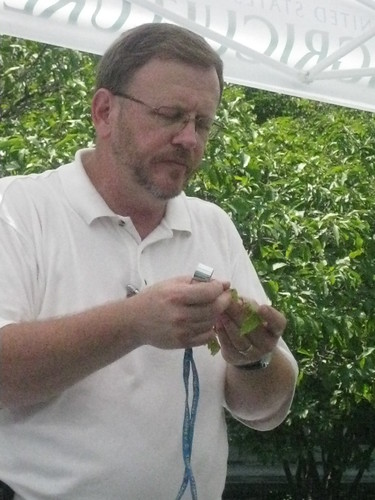Written by Kayla Harless, People’s Garden Intern
Almost everyone who gardens grows tomato plants. We are passionate about our tomatoes and savor that ripe, fresh fruit. However, several diseases love our tomato plants just as much as we do. The People’s Garden Workshop topic this week was tomato blights and spots, and Dr. Martin Draper, a plant pathologist through the USDA National Institute of Food and Agriculture, taught us how to identify them and what we can do to treat and prevent them.
He discussed in detail three pathogenic diseases: septoria leaf spot, early blight, and late blight. Don’t let the names early blight and late blight mislead you, they can appear at any time during the year. Septoria leaf spot is characterized by small, dark circular spots that often have yellow halos around them; they appear on the lower leaves of the plant first. Early blight can set in the stems and leaves, and is identified by legions with target-like rings. Late blight affects large portions of the leaves. It looks white and fuzzy on the underside of the leaf, and destroys crops quickly. Early and late blight affect potatoes as well, in fact, late blight caused the Irish potato famine.
These diseases can be spread many ways, and knowing what they are can supply simple solutions. Moisture, especially on the leaves, provides great conditions for the spores of these diseases to make themselves at home. Watering at the base of the plant can help prevent this; if you do use a sprinkler system or similar method to water your tomatoes, do so in the morning to allow the plant an opportunity to dry throughout the day. It is also recommended to stake your tomato plants instead of caging them, and space them appropriately. This way, the space will make it slightly more difficult for diseases to spread quickly, and the airflow will keep the plants dry. Keep a watch on your garden, and pluck any leaves that show signs of disease and take out infected plants.
Some fungicides can be very effective; however, it is important to follow the label. A fungicide intended for different plants, not vegetables, won’t make a difference and may cause problems. If you garden organically, adding compost extracts or teas can be a treatment. To create a solution that prevents and treats disease, add a heaping tablespoon of baking soda, a teaspoon of vegetable oil, and a small amount of mild soap to a gallon of water and spray the tomato plants with this solution. This needs to be reapplied regularly to maintain its efficiency. Garden clean-up is another preventative key, as the diseases’ spores can overwinter on plants left in the garden from the previous year.
There are many USDA extension offices throughout the country and research facilities on every land-grand university, so if you have further questions or concerns about tomato diseases feel free to contact one of these places.

